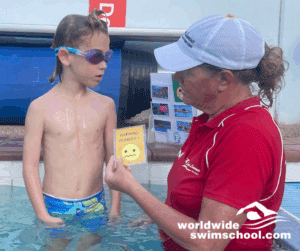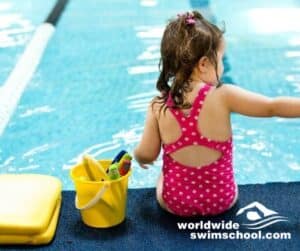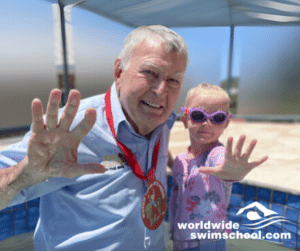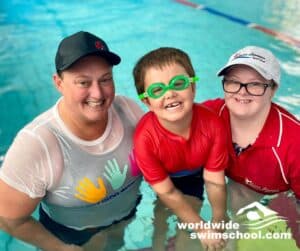Let's talk about making swimming fun for toddlers! If you have a spirited 2-year-old who's ready to make a splash, we've got just the expert tips and tricks to help you engage them in swimming lessons. From making them feel comfortable in the water to teaching essential skills, this article is your ultimate guide to engaging our 2 year old while learning how to swim.
Positive Learning Experience
Swim instructors should be aware that children’s early experiences in the water, will determine their future attitudes before you start their first class. For this reason, we should aim to make these early experiences positive safe and pleasurable in an attempt to shape a love of the water that that children will carry this important life skill with them through to adulthood.
Force has no place in the teaching of swimming and water safety. Teachers need to find engaging ways to encourage children to perform swimming activities voluntarily.
Before classes can take place children must feel comfortable in the water. Having shallow water is fantastic for teaching beginners. In fact for frightened beginners shallow water is vital. It allows the child to feel and be in control as they practice basic water familiarisation activities such as walking, jumping, splashing and attempting breath control activities like pouring water over their face or even attempting the skill self-submerging.
It can be Challenging
They are increasingly independent in their day to day life as they navigate activities and tasks and explore their surroundings.
The 2 year old is strong willed and know their own mind. Often the child is easily distracted or totally focused on their favourite activity. Being aware of these characteristics can help you in your swim lessons as you plan your class strategies and swimming programs.
While teaching a 2 year old to swim can present challenges, it is not without fun or reward. If you tackle it correctly, it will feel more like fun and play time than a job.
Change Activities Frequently
Using a wide range of activities can help keep the little swimmer interested in the task at hand. Challenging activities are a great tactic for the 2 year old child who is easily distracted or is bored quickly.
It is important to revisit activities to ensure the children are given enough time to practice and in-turn learn the swimming skills. Circuits are a great way to incorporate lots of activities while still allowing for much needed repetition.
Adapt to Student Led Learning Situations
This can be great for toddlers determined to do what they want, when they want. The swimmers will point in a direction or vocalise what activities interested in. Children are naturally curious.
By allowing this independent and exploratory type of learning, it can help you find out what the students like and what motivates them in the water.
This is particularly helpful for future planning allowing you to prepare swimming classes that will engage your students. Remember to teach activities so they still have purpose and focus on important swimming skills.
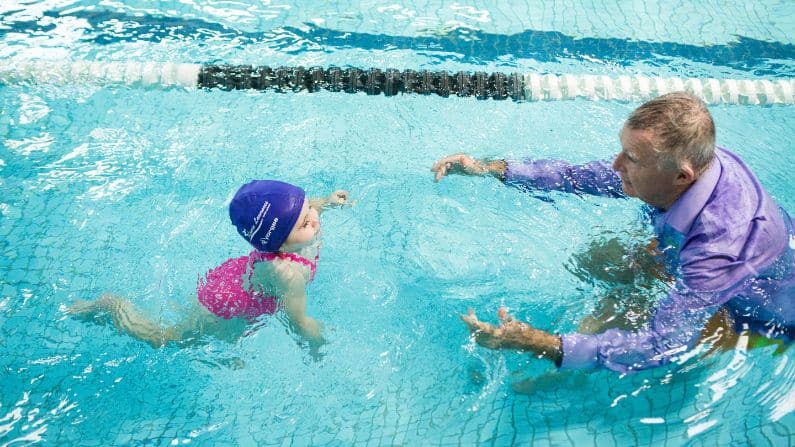
Control your Voice to Add Interest to the Class
Varying the tone and volume of your voice can keep young swimmers alert, interested and awaiting your instructions. Remember the learn to swim program will often be in swimming pools where other aquatic activities or classes going on at the same time.
Keep skill instructions simple and gather the group close together if you are in a noisy environment.
Skill Build
It is important that teachers don’t rush the water familiarisation stage with children. Basic swim skills like pool entry and exit, breath control, submersion and floating skills are all vital to a child’s progressive learning.
These simple floating skills, established early, will form the child’s base for learning to swim and stroke development. Teachers must remember that a float is the basis in a learn to swim program and must not be rushed. It must be mastered before trying more complex learn to swim skills.
If children learn to relax and float independently on their front and back for up to ten seconds, then once propulsive patterns are introduced a more relaxed stroke will be developed.
Swimming teachers often observe those children who struggle, thrash, and fight the water have difficulty keeping themselves afloat. Remember children need to develop at their own pace and build self confidence.
Communicate with Parents
Tapping into the knowledge of those closest to your swimmers will enable you to find out their likes, dislikes and motivating factors much quicker. Some swimmers may take longer to warm up to new faces and swimming instructors than others.
Knowing what motivates your students can help you build a bond fast and allow you to get to work on learn to swim skills right away.
Involve Parents
Parental involvement in the swimming lessons is essential to truly develop great swimming and water safety skills. The parents then become knowledgeable on building swimming and water safety skills in different environments and importantly understand their children’s capabilities in the water.
Furthermore, the individual attention children receive from their parents means they are capable of performing skills independently in the water at a much earlier age.
- Educate parents on swimming and water safety skills.
- Have parents understand their child’s physical and developmental abilities in the water.
- Create a safe and secure learning environment.
- Teach children they must always swim with adults.
- Allow maximum practice time in the lesson.
- Develop exceptional swimming skills at the earliest possible age, and
- Encourage parents to practice with their child outside of the classes to build greater confidence.
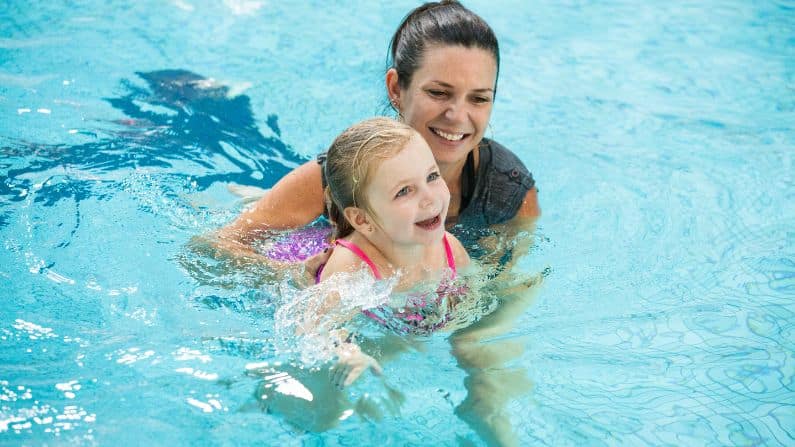
Role of the Swim Teacher
Trust
Developing trust is the key with beginners. Teachers should always follow through with things that they tell their student’s.
Consistent teacher
Consistent teacher is critical. Frequently changing teachers is also detrimental for beginner swimmers just as they gain trust in one instuctor, another is thrust upon them. Beginner learners respond positively to routines and familiar surroundings and situations, for this reason following a similar lesson plan from week to week, while gradually building on skills and confidence will help to progress students faster.
Children need success
Children need success in the learn to swim lesson so that they feel good about themselves and become eager to learn. Attentive instructors who give positive reinforcement is so important. Giving genuine praise for attempts and triumphs will keep children interested in the class and want them to continue to improve.
How to find Swimming Lessons Near Me
If you are a parent seeking swimming and water safety lessons near me for your toddler, rest assured that there are various reliable methods to find appropriate options.
- Firstly, leveraging the power of the internet is essential in this digital age. Conducting a simple search using the keywords "swimming lessons near me" on popular search engines will yield numerous results tailored to your location.
- Websites specializing in listing local swimming schools or community centers offering swim programs often provide detailed information about their facilities, instructors' qualifications, and class schedules.
- Additionally, social media platforms can be valuable resources as local parenting groups frequently share recommendations and reviews of nearby swim class providers.
- To ensure credibility and quality instruction, it is prudent to verify the reputation of a swim school by checking online ratings or even reaching out directly via email or phone for further inquiries.
Finally, consulting with other parents who have already enrolled their toddlers in swim lessons could provide invaluable insights into personalized experiences and direct you toward trusted establishments within close proximity to your locality.
Watch this Video
Watch this footage of Laurie Lawrence and granddaughter Harper having fun while exploring the water in their swimming lesson together.
Harper is striking out independently in the water, and is clear in what she wants to do and where she wants to swim.
Laurie happily obliges and expertly guides the activities to ensure there is still learning value.
They work on breath control, turning, swimming varied distances, and controlled propulsive skills in a short space of time.
Questions
Which age is best for swimming?
We believe the best time to start formal learn to swim lessons is at 4 months of age. By four months parents are relaxed handling baby, the baby has good neck control and baby is interested in new and exciting situations.
Does my child need to wear goggles?
Goggles are not a necessity, however, they may help if children have sensitive or sore eyes. With goggles, it is important that children do not become reliant on them. This means leaving goggles at home every second week or only allowing children to wear goggles for half the lesson.
Read more articles by World Wide Swim School.
Access more under 5 resources from Kids Alive
Take a look at our Swim Library online resource for teaching two year olds how to swim.


